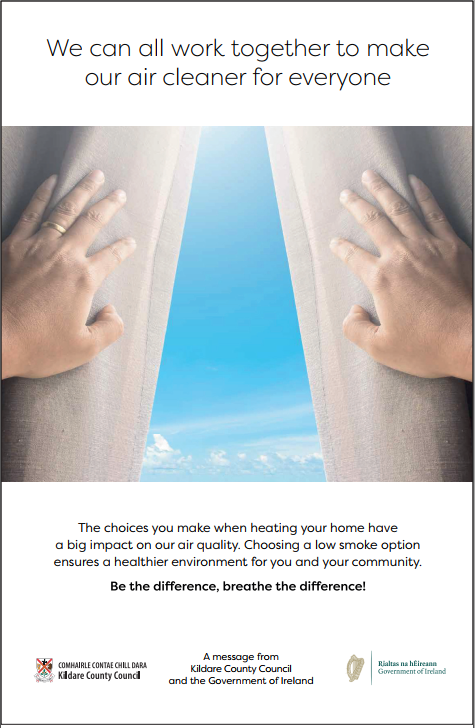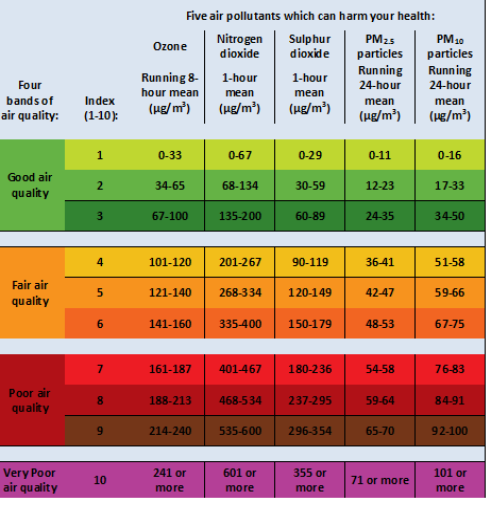Frequently Asked Questions regarding Low Smoke Solid Fuel Householder in the Low Smoke Zone What is a Low Smoke Zone?
It is an area designated under the Air Pollution Act Regulations 2012-2020, to protect public health, where certain solid fuels cannot be marketed, sold or used.
It is an area designated under the Air Pollution Act Regulations 2012-2020, to protect public health, where certain solid fuels cannot be marketed, sold or used.
What is the legal basis for establishing Low Smoke Zones?
The sale, marketing, distribution and burning of bituminous (smoky) coal is prohibited under the provisions of the Air Pollution Act (Marketing, Sale, Distribution and Burning of Specified Fuels) Regulations 2012-2020.
The sale, marketing, distribution and burning of bituminous (smoky) coal is prohibited under the provisions of the Air Pollution Act (Marketing, Sale, Distribution and Burning of Specified Fuels) Regulations 2012-2020.
Can I burn bituminous(smoky) coal outside of the Low Smoke Zones?
Yes, butbituminous coal must contain less than 0.7% sulphur, and must comply with SWiFT 7 or an equivalent recognised standard. https://swift7.certificationeuropeacademy.com/swift7-explained/
Yes, butbituminous coal must contain less than 0.7% sulphur, and must comply with SWiFT 7 or an equivalent recognised standard. https://swift7.certificationeuropeacademy.com/swift7-explained/
Why regulate these fuels?
The burning of smoky coal releases toxic emissions (including fine particles or PM2.5) into the atmosphere. There is no safe level for exposure to fine particles; negative effects have been observed at even low levels of exposure.
The burning of smoky coal releases toxic emissions (including fine particles or PM2.5) into the atmosphere. There is no safe level for exposure to fine particles; negative effects have been observed at even low levels of exposure.
Air pollution can build up outdoors, as well as in private houses and have a detrimental effect on health. Fine particles get deep into the lungs and into the bloodstream, where it is carried around the bodycausing cardiovascular disease.
Other toxic substances are present in coal and are released to the air when it is burned; these includemercury, cadmium and arsenic.
What are the health issues associated with burning smoky coal?
Fines particles (PM2.5) released during the burning of smoky coal can spark asthma attacks, and can cause a range of respiratory problems such as bronchitis, bronchiolitis (affects 1/4 children under the age of two),
Fines particles (PM2.5) released during the burning of smoky coal can spark asthma attacks, and can cause a range of respiratory problems such as bronchitis, bronchiolitis (affects 1/4 children under the age of two),
pneumonia, chronic obstructive pulmonary disease, lung cancer & others. PM2.5 has also been associated with strokes, heart attacks, & other
cardiovascular conditions. Burning of smoky coal affects the external environment, but also the internal environment of homes where burned.
cardiovascular conditions. Burning of smoky coal affects the external environment, but also the internal environment of homes where burned.
How do I find out if I am a Low Smoke Zone?
To establish if you are living in a Low Smoke Zone, please click onthe following link: https://dcenr.maps.arcgis.com/apps/webappviewer/index.html?id=feee728a0ee1427d9a3973a090a9f292you can then input your eircode or use the search by address option.
To establish if you are living in a Low Smoke Zone, please click onthe following link: https://dcenr.maps.arcgis.com/apps/webappviewer/index.html?id=feee728a0ee1427d9a3973a090a9f292you can then input your eircode or use the search by address option.
Is it illegal to burn smoky coal in a Low Smoke Zone?
Yes, Article 6 of the Regulations prohibits the burning of smoky coal in the Low Smoke Zone.
Yes, Article 6 of the Regulations prohibits the burning of smoky coal in the Low Smoke Zone.
What is “low smoke fuel”?
Low smoke fuel is a fuel permitted for sale in a Low Smoke Zone and emits less black smoke than comparable fuels. Black smoke contains high levels of PM2.5, which is harmful to the environment and to human health.
Low smoke fuel is a fuel permitted for sale in a Low Smoke Zone and emits less black smoke than comparable fuels. Black smoke contains high levels of PM2.5, which is harmful to the environment and to human health.
Low smoke fuel emits some smoke while igniting, but when burning efficiently, emits less smoke.
How do I know if my fuel is an approved low smoke fuel?
All fuel which is sold as “low smoke coal” should come in sealed bags carrying the wording “APPROVED FUEL -Contents comply with the Air Pollution Act Regulations” and should have the Swift 7 logo on the bag.
All fuel which is sold as “low smoke coal” should come in sealed bags carrying the wording “APPROVED FUEL -Contents comply with the Air Pollution Act Regulations” and should have the Swift 7 logo on the bag.
What fuels may I not burn in my home in a low smoke zone?
You may not burn bituminous coal, which is often marketed as “Polish Coal”, “Columbian Coal”,“Texan Coal”,“Russian Coal”,“Premium Coal” or “House Coal”. In addition, you may not burn waste timber particularly that
You may not burn bituminous coal, which is often marketed as “Polish Coal”, “Columbian Coal”,“Texan Coal”,“Russian Coal”,“Premium Coal” or “House Coal”. In addition, you may not burn waste timber particularly that
which has been treated, painted, varnished, lacquered, glued, or had any substance added as this causes the release of toxic and cancer causing air pollutants. Where wood logs/blocks are used, these should be dry, to improve energy efficiency and to avoid excess emissions of
creosote, which can build up in your chimney and lead to chimney fires. A creosote chimney fire can burn hot enough to crack a chimney flue or even the chimney breast. NOTE: It is illegal(regardless of whether you live inside or outside the Low SmokeZone) to burn domestic waste.
Is it true that low smoke coal products are more difficult to light than Polish coal?
Low Smoke fuel maytake slightly longer to light than Polish coal, but the method is the same. Start with firelighters and kindling. How much kindling you use will depend on your fuel.
Low Smoke fuel maytake slightly longer to light than Polish coal, but the method is the same. Start with firelighters and kindling. How much kindling you use will depend on your fuel.
If you are using peat or timber briquettes or turf as a starting fuel you will need less kindling.Avoid loading your fire with low smoke coal until thefire has started burning well. This allows plenty of air to rise through the fire in the initial stages.
I’ve been told that low smoke coal gives less heat than bituminous coal. Is this true?
No. There are several types of “low smoke coal”, of varying qualities, just as there are several types of bituminous coal. There are large ovoids, small ovoids, large lignite briquettes, small
No. There are several types of “low smoke coal”, of varying qualities, just as there are several types of bituminous coal. There are large ovoids, small ovoids, large lignite briquettes, small
ovoids & pet coke. Some fuels are more suitable for open fires, while others are more suitable for enclosed appliances such as stoves. With the right type of Low Smoke fuel for your fire or stove, there is no reason why your heat output can’t match that of a bituminous coal fire.
Low smoke coal is more expensive than bituminous coal. How can it be better value to burn it?
Low smoke coal is generally a bit more expensive to buyper bag, but, if you are burning the right mix of low smoke fuel, your fire can burn as hot, and for longer, than the cheaper coal,
Low smoke coal is generally a bit more expensive to buyper bag, but, if you are burning the right mix of low smoke fuel, your fire can burn as hot, and for longer, than the cheaper coal,
I’ve noticed my low smoke fire doesn’t have the same flame of a smoky coal fire.
This is true; generally speaking, theres less flame from low smoke coal than from bituminous coal. This is because the fuels being more completely burned & is the reason it’s more energy efficient.
This is true; generally speaking, theres less flame from low smoke coal than from bituminous coal. This is because the fuels being more completely burned & is the reason it’s more energy efficient.
You can add lignite nuggets, turf or wood for extra flame, but you will reduce the efficiency and heat output. However, if you keep in mind that you are safeguarding your family’s health and that of your neighbours by burning low smoke fuel, this is a small price to pay.
Should I report a neighbour if I suspect that they are burning smoky coal? Yes. Your health and that of your communityis at risk from your neighbour’s smoky coal. The burning of smoky coal in the Low Smoke Zone is a selfish, anti-social act, which should be reported.Your Local
Authority will investigate and, as appropriate, in the first instance provide information on residents’ obligations.
How can I be sure that a neighbour is burning smoky coal?
This is best judged on a calm day when the fire has been burning for some considerable time. If the neighbour’s chimney smoke is considerably blacker and thicker than other chimneys, then smoky coal may be the cause.
This is best judged on a calm day when the fire has been burning for some considerable time. If the neighbour’s chimney smoke is considerably blacker and thicker than other chimneys, then smoky coal may be the cause.
However, this can alsobe caused by a dirty chimney. If you are living in the Low Smoke Zone, you may in time come to notice that smoky coal has a distinctive smell. If a coalman is seen delivering smoky coal in the low smoke coal zone, or selling any fuel while carrying smoky
coal on his truck, the number of the truck should be reportedto your local authority, along with the name of the delivery person and the address of the customer if possible.
Do Council employees call to private houses to inspect the type of fuel burned?
Yes. If a person authorised under the 2012 Regs suspects that smoky coal is being burned at a private house in the LSZ, that person may call to investigate, & may ask you to show a sample of the fuel
Yes. If a person authorised under the 2012 Regs suspects that smoky coal is being burned at a private house in the LSZ, that person may call to investigate, & may ask you to show a sample of the fuel
you are burning.
How will I know if a person calling to my home is genuinely a Local Authority employee?
Any person authorised under the Regulations will identify themselves when making an inspection, and will show you an official identification card.
How will I know if a person calling to my home is genuinely a Local Authority employee?
Any person authorised under the Regulations will identify themselves when making an inspection, and will show you an official identification card.
If you are unsure, you may ask the person to give you a telephone number which you can contact to verify that they aregenuine. An authorised person will not ask to enter inside your house.
What if I refuse to cooperate with an authorised person of the local authority?
To obstruct an authorised person in the performance of their duty is an offence under the Regulations.
To obstruct an authorised person in the performance of their duty is an offence under the Regulations.

 Read on Twitter
Read on Twitter




